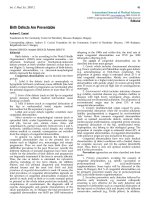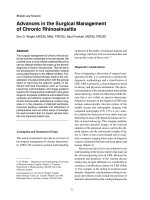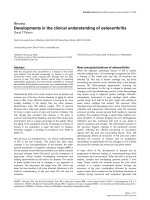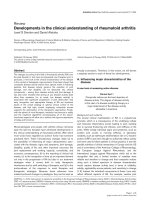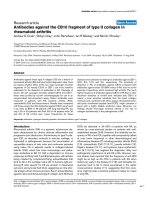Báo cáo y học: "ahead at the potential benefits of biotechnology-derived allergen therapeutics" potx
Bạn đang xem bản rút gọn của tài liệu. Xem và tải ngay bản đầy đủ của tài liệu tại đây (218.8 KB, 4 trang )
BioMed Central
Page 1 of 4
(page number not for citation purposes)
Clinical and Molecular Allergy
Open Access
Commentary
Looking ahead at the potential benefits of biotechnology-derived
allergen therapeutics
Jason Behrmann*
Address: Programmes de bioéthique, Université de Montréal, C.P. 6128, succursale centre-ville, Montréal, Québec, H3C 3J7, Canada
Email: Jason Behrmann* -
* Corresponding author
Abstract
While biotechnology-derived allergen therapeutics show promise in improving the safety of
immunotherapy, they may prove to have additional benefits in comparison to conventional
allergenic extracts that deserve commentary. These issues range from product stability and
compatibility to medical practice issues, which will be the focus of this article.
Background
Allergies, or hyperimmune responses to ordinary entities
in our environment, are extremely common chronic path-
ological conditions that affect 10 to 25% of the popula-
tion [1,2] and have significant impacts on productivity,
quality of life issues, and costs towards the administration
of health services [3]. Common practices for ameliorating
allergy symptoms include allergen avoidance, allergen
elimination, pharmacotherapy (such as the administra-
tion of anti-histamines), and allergen-specific immuno-
therapy. Allergen-specific immunotherapy (SIT) was
developed in 1911 [4] and is the only treatment that
attends to the root cause, rather than the clinical symp-
toms, of allergic reactions. The most common method of
SIT employs the subcutaneous injection of extracts of bio-
logical material that contains the allergen. Gradual,
increasing doses of the administered allergenic extract
serves to physiologically moderate the immune system so
that it is less primed for a hyperimmune response upon
subsequent exposure to the allergen (for a concise review,
see: [5], p. 49–51). An inherent problem with SIT is that it
carries a low but significant risk of inducing severe and
sometimes fatal systemic reactions such as anaphylaxis
[6]. It is therefore advised that SIT be performed by trained
allergists in facilities that are equipped to treat anaphylac-
tic reactions, and that patients be monitored for 30 min-
utes after the treatment [5].
After decades of using biologic extracts for SIT, technology
has progressed to the point where the corresponding
genes for key allergens have been identified and cloned,
making possible the production (and strategic modifica-
tion) of recombinant allergens via biotechnological tech-
niques [Allergen products [7]]. Of particular interest is the
potential, noted in several reviews, for the development of
novel drugs that can minimize the possibility of adverse
reactions to immunotherapy [8,9]. Added to the fact that
recombinant allergens could be purified to near homoge-
neity – an improvement to current extracts that are com-
plex mixtures containing largely non-allergenic and
uncharacterized material – recombinant allergens are
being engineered to have reduced IgE immunoglobulin
binding capacity while retaining their therapeutic
attributes for immunotherapy. This essentially means that
future immunotherapy might be performed with 'hypo-
allergenic' allergens that pose little risk for anaphylactic
reactions.
Published: 4 July 2007
Clinical and Molecular Allergy 2007, 5:3 doi:10.1186/1476-7961-5-3
Received: 17 April 2007
Accepted: 4 July 2007
This article is available from: />© 2007 Behrmann; licensee BioMed Central Ltd.
This is an Open Access article distributed under the terms of the Creative Commons Attribution License ( />),
which permits unrestricted use, distribution, and reproduction in any medium, provided the original work is properly cited.
Clinical and Molecular Allergy 2007, 5:3 />Page 2 of 4
(page number not for citation purposes)
With the possibility of batch production of homogenous
allergen proteins via biotechnological techniques, the
opportunity to increase the therapeutic efficacy of allergen
vaccines can surface through conjugation of the purified
allergen to immunostimulatory DNA moieties [reviewed
in: [10]]. Unmethylated CG dinucleotide DNA sequences,
found in certain bacterial species, possess immunostimu-
latory capacities [11]. Interestingly, conjugation of syn-
thetic versions of these DNA sequences to major short
ragweed allergen (Amb a 1) has been shown to enhance
the immunogenicity, while lowering the allegenicity, of
the protein [12]. Accumulative research is dissecting the
mechanism behind the improved therapeutic efficacy of
immunostimulatory DNA-conjugated allergens (ISD-
allergens). In brief, the DNA conjugates appear to stimu-
late the immune system so that the development of a Th1-
type immune response (immunotherapeutic IgG anti-
body production) is favoured over a Th2-type response
(IgE and inflammatory cytokine production) [10]. Prelim-
inary studies demonstrate that the allergenicity of ISD-
allergen products have the potential to be several folds
less allergenic than conventional allergenic extracts
[10,13]. These observations suggest that vaccines of aller-
gens conjugated to immunostimulatory DNA moieties
could ameliorate the safety and efficacy of future SIT
regimes.
Further biotechnological developments raise the possibil-
ity that proteinaceous vaccines for allergen-specific immu-
notherapy may one day combat allergies alongside
plasmid-DNA (pDNA) vaccines [14,15]. Instead of inject-
ing allergenic material, bacterially-produced plasmids
encoding for the allergenic entity could be used to pro-
duce the allergen endogenously once transfected into the
recipient's cells. Though still in the early stages of develop-
ment (thus the clinical efficacy of these drugs is highly
debateable), preliminary results from mouse models
show that pDNA vaccines may be suitable for SIT and
other forms of immunization [16-18]. Furthermore, a
study by McConkey and colleagues [19] demonstrated
that immunization with plasmid vaccines in conjunction
with proteinaceous vaccines greatly augmented the
immune response in comparison to vaccination with the
proteinaceous vaccine alone. An interesting attribute of
the pDNA vaccine is that since the allergen is produced
endogenously, it is presented to the immune system at a
very low concentration over a prolonged period. The slow
production of allergen makes it virtually impossible for a
severe hyperimmune response to occur, as can be the case
with conventional allergenic extracts. Thus, life-threaten-
ing systemic reactions appear unlikely with pDNA vac-
cines [17], which would further increase the safety and
utility of SIT.
Biotechnology has the potential for the development of
novel drugs for the treatment of allergies that may have
several attributes that are distinct from current therapeu-
tics. While these innovations are known to differ at the
molecular and pharmacological level, they may have
broader implications related to medical practice and pro-
tocols for the treatment of allergies that are less predicta-
ble.
Discussion
Stability and compatibility of therapeutics
An unwanted attribute of some allergenic extracts is that
the final product may contain proteolytic enzymes. This is
observed particularly in extracts made from biologic
material of dust mites, cat and dog pelts, and some pollen
varieties [20]. Endogenous protease activity is problem-
atic because it can degrade active ingredients in the thera-
peutic, resulting in reduced product stability and shelf-life
[21]. Stability can be ameliorated by formulating the
extract in glycerol [22], but these products are not
favoured since glycerol produces pain at the injection site
[5]. Moreover, since many patients undergoing SIT are
allergic to more than one allergen, the mixing of allergenic
extracts is often required to include all of the relevant
allergens [5]. The mixing of proteolytic extracts with oth-
ers must be avoided – usually by isolating specific extracts
in distinct vials – but the therapeutic regime will require
additional injections for the distinct extracts, which can
make the therapy less pleasant for the patient. Deciding
what extracts are compatible with each other may also
prove difficult as the potential for proteolytic activity in an
extract is not marked on the product label. However,
problems associated with proteolytic degradation could
be circumvented with recombinant allergens, which 1)
would not be contaminated with unwanted proteolytic
enzymes, and 2) could be genetically engineered to be free
of proteolytic function. In summary, recombinant aller-
gen products formulated to be free of proteolytic activity
may be of increased stability without the need for glycerol
and may be easier to formulate as mixtures for individual-
ized therapeutic regimes.
Minimizing localized and systemic reactions: broader
implications
The ramifications of minimizing localized and systemic
reactions, especially anaphylaxis, through the application
of less allergenic varieties of recombinant allergens and
ISD-allergens, or pDNA vaccines, could be far reaching.
Current allergenic extracts have a high propensity to pro-
duce localized reactions such as itchiness and swelling at
the injection site. For most patients, this is a mild annoy-
ance, but this can be a significant psychological factor
when administering SIT to young children [23]. Less aller-
genic recombinant varieties or pDNA versions could elim-
inate localized reactions altogether, while also removing
Clinical and Molecular Allergy 2007, 5:3 />Page 3 of 4
(page number not for citation purposes)
the need for the 30 minute precautionary wait time cur-
rently necessary to monitor for anaphylaxis. This in turn
would free-up time and space within allergy clinics, allow-
ing for more prompt treatment of additional patients and
could produce monetary savings to the healthcare system.
Additionally, the shorter time within the allergy clinic in
this situation may improve patient compliance with the
therapeutic regime. The wait time is viewed by many
patients, as observed by experts [24], as a displeasure and
motivates some to terminate the therapeutic regime pre-
maturely.
Expanding treatment options
The incidence of allergies within the general population is
increasing in prevalence [25,26], and will necessitate
broader access to appropriate therapies. Such a demand
will be problematic without sufficient numbers of allergy
specialists, especially in remote areas. The potentially
increased safety of biotechnology-derived allergen thera-
peutics raises the real possibility of being able to adminis-
ter therapeutic regimes through general health care
facilities that need not be equipped to treat anaphylactic
reactions. This would allow much broader access to SIT
and permit allergists to focus their resources on the diag-
nosis and evaluation of therapeutic needs for patients. As
an aside, the American College of Allergy, Asthma &
Immunology [27] has noted that managed care practices
for health services in the U.S. have encouraged the admin-
istration of immunotherapy by primary care physicians.
Biotechnology-derived allergen therapeutics would be a
more appropriate (and safer) product for primary care
physicians than current SIT allergen products, and likely
improve patient compliance.
Recombinant and ISD-allergens may make certain risky
but effective SIT protocols more acceptable, as in the case
of rush immunotherapy. In rush immunotherapy, large
doses of an allergenic extract are administered over a very
short period of time, such that the maximum dose level of
the therapeutic is reached within hours to days, instead of
weeks or months for conventional SIT [24]. While greatly
increasing efficiency (and also patient compliance), rush
immunotherapy is burdened with a significantly higher
incidence of adverse reactions (18 times more prevalent
than with conventional SIT [5]). Were rush protocols to
be performed with less allergenic recombinant or ISD-
allergens, one could foresee the benefits of expedited
immunotherapy and compliance without the associated
safety concerns.
Conclusion
While the science of biotechnology-derived allergy thera-
peutics is attractive and has drawn recent attention, the
potential benefits of these therapeutics for improving
therapeutic protocols, patient compliance, and broader
administration of immunotherapy is equally attractive. At
the moment, the potential benefits of biotechnology in
the field of allergy treatment can only be envisioned, and
whether these benefits will indeed manifest still requires
many years of research – the results from clinical trials of
biotechnology-derived allergen therapeutics are eagerly
awaited and the commercialization of a variety of these
products appears likely [28]. Thus, it appears that after
decades of using crude extracts of biological material for
SIT, the realm of allergy therapeutics is positioned to enter
the biotech sphere that has proven its revolutionary
potential in numerous fields ranging from oncology and
HIV therapeutics to vaccines [29].
Competing interests
The author(s) declare that they have no competing inter-
ests.
Acknowledgements
Many thanks are extended to Dr. Bryn Williams-Jones of the Université de
Montréal for helpful comments on this manuscript. Funding support was
provided by the APOGEE-Net network of Montréal, Québec, Canada.
References
1. Bousquet J, Ansotegui IJ, van Ree R, Burney PG, Zuberbier T, van
Cauwenberge P: European Union meets the challenge of the
growing importance of allergy and asthma in Europe. Allergy
2004, 59(1):1-4.
2. Bousquet J, Van Cauwenberge P, Khaltaev N: Allergic rhinitis and
its impact on asthma. J Allergy Clin Immunol 2001, 108(5
Suppl):S147-334.
3. Gerth van Wijk R: Allergy: a global problem. Quality of life.
Allergy 2002, 57(12):1097-1110.
4. Noon L: Prophylactic inoculation against hay fever. Lancet
1911, 1:1572-1573.
5. Leith E, Bowen T, Butchey J, Fischer D, Kim H, Moote B, Small P, Stark
D, Waserman S: Consensus guidelines on practical issues of
immunotherapy Canadian Society of Allergy and Clinical
Immunology (CSACI). Allergy, Asthma, and Clinical Immunology
2006, 2:47-61.
6. Reid MJ, Lockey RF, Turkeltaub PC, Platts-Mills TA: Survey of fatal-
ities from skin testing and immunotherapy 1985-1989. J
Allergy Clin Immunol 1993, 92:6-15.
7. Allergen products. Allergy 2006, 61 (s82):3-5.
8. Bhalla PL, Singh MB: Engineered allergens for immunotherapy.
Curr Opin Allergy Clin Immunol 2004, 4(6):569-573.
9. Westritschnig K, Valenta R: Can we genetically engineer safer
and more effective immunotherapy reagents? Curr Opin Allergy
Clin Immunol 2003, 3(6):495-500.
10. Creticos PS, Chen YH, Schroeder JT: New approaches in immu-
notherapy: allergen vaccination with immunostimulatory
DNA. Immunol Allergy Clin N Am 2004, 24:569-581.
11. Krieg AM, Yi AK, Matson S, Waldschmidt TJ, Bishop GA, Teasdale R,
Koretzky GA, Klinman DM: CpG motifs in bacterial DNA trig-
ger direct B-cell activation. Nature 1995, 374(6522):546-549.
12. Tighe H, Takabayashi K, Schwartz D, Van Nest G, Tuck S, Eiden JJ,
Kagey-Sobotka A, Creticos PS, Lichtenstein LM, Spiegelberg HL, Raz
E: Conjugation of immunostimulatory DNA to the short rag-
weed allergen amb a 1 enhances its immunogenicity and
reduces its allergenicity. J Allergy Clin Immunol 2000, 106(1 Pt
1):124-134.
13. Tulic MK, Fiset PO, Christodoulopoulos P, Vaillancourt P, Desrosiers
M, Lavigne F, Eiden J, Hamid Q: Amb a 1-immunostimulatory oli-
godeoxynucleotide conjugate immunotherapy decreases
the nasal inflammatory response. J Allergy Clin Immunol 2004,
113(2):235-241.
14. Toda M, Sato H, Takebe Y, Taniguchi Y, Saito S, Inouye S, Takemori
T, Sakaguchi M: Inhibition of immunoglobulin E response to
Publish with BioMed Central and every
scientist can read your work free of charge
"BioMed Central will be the most significant development for
disseminating the results of biomedical research in our lifetime."
Sir Paul Nurse, Cancer Research UK
Your research papers will be:
available free of charge to the entire biomedical community
peer reviewed and published immediately upon acceptance
cited in PubMed and archived on PubMed Central
yours — you keep the copyright
Submit your manuscript here:
/>BioMedcentral
Clinical and Molecular Allergy 2007, 5:3 />Page 4 of 4
(page number not for citation purposes)
Japanese cedar pollen allergen (Cry j 1) in mice by DNA
immunization: different outcomes dependant on the plas-
mid DNA inoculation method. Immunology 2000, 99:179-186.
15. Peng HJ, Su SN, Chang ZN, Chao PL, Kuo SW, Tsai LC: Induction
of specific Th1 responses and supression of IgE antibody for-
mation by vaccination with plasmid DNA encoding Der f 11.
Vaccine 2002, 20:.
16. Tighe H, Corr M, Roman M, Raz E: Gene vaccinations: plasmid
DNA is more than just a blueprint. Immunol Today 1998,
19:89-97.
17. Raz E, Tighe H, Sato Y, Corr M, Dudler JA, Roman M, Swain SL,
Spiegelberg HL, Carson DA: Preferential induction of a Th1
immune response and inhibition of specific IgE antibody for-
mation by plasmid DNA immunization. Proc Natl Acad Sci 1996,
93:5141-5145.
18. Lowrie DB, Silva CL, Colston MJ, Ragno S, Tascon RE: Protection
against tuberculosis by a plasmid DNA vaccine. Vaccine 1997,
15:834-838.
19. McConkey SJ, Reece WH, Moorthy VS, Webster D, Dunachie S,
Butcher G, Vuola JM, Blanchard TJ, Gothard P, Watkins K, Hannan
CM, Everaere S, Brown K, Kester KE, Cummings J, Williams J, Hepp-
ner DG, Pathan A, Flanagan K, Arulanantham N, Roberts MT, Roy M,
Smith GL, Schneider J, Peto T, Sinden RE, Gilbert SC, Hill AV:
Enhanced T-cell immunogenicity of plasmid DNA vaccines
boosted by recombinant modified vaccinia virus Ankara in
humans. Nat Med 2003, 9(6):729-735.
20. Li JT, Lockey RF, Bernstein IL, Portnoy JM, Nicklas RA: Allergen
immunotherapy: a practice parameter. Ann Allergy Asthma
Immunol 2003, 90:1-42.
21. Esch RE: Role of proteases on the stability of allergenic
extracts . Volume 85. Edited by: Impfstoffe) APEIBS. Stuttgart, Ger-
many , Gustav Fischer Verlag; 1992.
22. Esch RE: Allergen source materials and quality control of
allergenic extracts. Methods 1997, 13(1):2-13.
23. Ownby DR, Adinoff AD: The appropriate use of skin testing and
allergen immunotherapy in young children. J Allergy Clin Immu-
nol 1994, 94:662-665.
24. Malling HJ: Minimising the risks of allergen-specific injection
immunotherapy. Drug Saf 2000, 23(4):323-332.
25. Sly RM: The changing prevalence of allergic rhinitis and
asthma. Ann Allergy Asthma Immunol 1999, 82:233-248.
26. Holgate ST: The epidemic of allergy and asthma. Nature 1999,
402 (6760 Suppl):B2-B4.
27. Position statement on the administration of immuno-
therapy outside of the prescribing allergist facility.Drugs and
Anaphylaxis Committee of the American College of Allergy,
Asthma and Immunology. Ann Allergy Asthma Immunol 1998,
81(2):101-102.
28. Niederberger V, Valenta R: Recombinant allergens for immuno-
therapy. Where do we stand? Curr Opin Allergy Clin Immunol 2004,
4:549-554.
29. Lawrence S: Billion dollar babies biotech drugs as blockbust-
ers. Nature Biotechnology 2007, 25:380-382.
